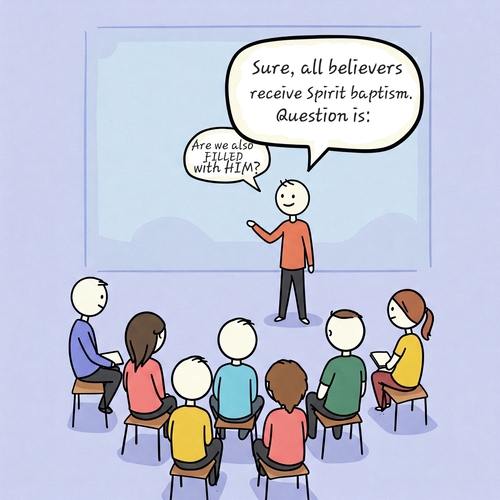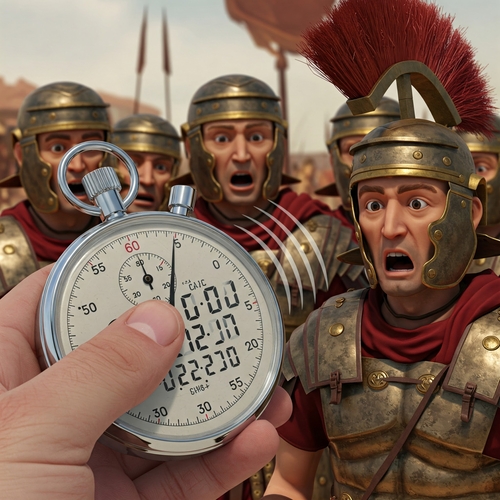Are the Gospels Eyewitness Accounts? The Mounting Evidence
For centuries, Christians have affirmed the Gospels were written either by direct eyewitnesses to Jesus’s ministry (Matthew and John) or by those with access to eyewitness testimony (Mark and Luke). In recent decades, however, the traditional view has faced significant challenges from critical scholars who propose later dating, anonymous authorship, or composition by communities rather than individuals.
A careful examination of both ancient and recent evidence, however, reveals a compelling case for the traditional view. Join us as we explore the mounting evidence that supports the eyewitness origins of the four Gospels.
THE HISTORICAL CONTEXT OF GOSPEL AUTHORSHIP
Traditional dating places Matthew in the 50s-60s AD, Mark in the late 50s-early 60s, Luke in the early 60s, and John in the 80s-90s AD. Critical scholars typically push these dates forward by 10-30 years. However, even with the later dating, all four Gospels would have been written within the lifetime of at least some eyewitnesses to Jesus’s ministry.
The first-century Jewish culture in which the Gospels originated placed tremendous emphasis on accurate oral tradition. Unlike modern Western societies, ancient Near Eastern cultures were highly skilled at preserving important information orally. Studies of oral cultures show that groups develop mechanisms to ensure the faithful transmission of significant traditions, especially when those traditions have religious significance.
Furthermore, the early church recognised the concept of apostolic authority. Documents connected to apostles or their close associates were valued precisely because they provided authentic testimony about Jesus. This creates a historical context in which eyewitness testimony was both possible and prized.
INTERNAL EVIDENCE FOR EYEWITNESS AUTHORSHIP
The Gospel texts themselves contain numerous indications of eyewitness origins:
Vivid Descriptive Details: The Gospels contain precise geographical, architectural, and cultural details that would be difficult for non-eyewitnesses to fabricate, especially decades after the events and in the aftermath of Jerusalem’s destruction in 70 AD.
For example, John 5:2 mentions “a pool, which is called in Hebrew Bethesda, having five porticoes.” Archaeological excavations have confirmed this unusual five-porched structure. Similarly, Mark records Jesus “sat down opposite the treasury” (Mark 12:41)—a specific location in the Temple that Mark describes casually, assuming his readers would understand.
John’s Gospel mentions the Sea of Galilee is also called the “Sea of Tiberias” (John 6:1), a name that only came into use after Herod Antipas built the city of Tiberias around 20 AD. This reflects knowledge of the changing local terminology for this body of water over time.
The Gospels frequently mention specific times of day, weather conditions, seating arrangements, and other peripheral details that suggest the accounts come from those who were actually present:
- “And it was about the sixth hour” (John 19:14)
- “The wind was contrary to them” (Mark 6:48)
- “Jesus was in the stern, asleep on the cushion” (Mark 4:38)
- “There was much grass in the place” (John 6:10)
Psychological Realism: The Gospels display a psychological realism in their portrayal of the disciples and their interactions with Jesus. The disciples are frequently depicted as confused, afraid, or failing to understand Jesus’s teachings—hardly the portrait we would expect if the accounts were later idealisations.
For instance, Mark (widely believed to record Peter’s testimony) frequently portrays Peter in an unflattering light, including his rebuke by Jesus (Mark 8:33) and his denial (Mark 14:66-72). This self-deprecating portrayal suggests authentic recollection rather than later myth-making.
The Gospels also capture psychological nuances such as Jesus’s emotions—details that suggest these are the observations of those who knew Jesus personally:
- “He sighed deeply in his spirit” (Mark 8:12)
- “Jesus wept” (John 11:35)
- “Looking at them with anger, grieved at their hardness of heart” (Mark 3:5)
Undesigned Coincidences: Another fascinating line of evidence comes from what scholars call “undesigned coincidences”—cases where one Gospel casually mentions a detail that happens to explain a question raised in another Gospel, without any apparent coordination.
For example, in John 6:5-7, Jesus asks Philip specifically where they can buy bread to feed the crowd. Why Philip? John doesn’t say. But Luke 9:10 mentions the feeding miracle took place near Bethsaida—which John 1:44 tells us was Philip’s hometown. This connection between accounts suggests independent eyewitness testimony rather than mere copying. FOR MORE DETAILS
EXTERNAL EVIDENCE SUPPORTING EYEWITNESS AUTHORSHIP
The testimony of early Christian writers provides strong support for the traditional view of Gospel authorship.
Early Church Testimony: Papias, writing around 110 AD, explains the origins of Mark’s Gospel:
“Mark, having become the interpreter of Peter, wrote down accurately, though not in order, whatsoever he remembered of the things said or done by Christ. For he neither heard the Lord nor followed him, but afterward, as I said, he followed Peter, who adapted his teaching to the needs of his hearers.”
This account, preserved by Eusebius, directly connects Mark’s Gospel to Peter’s eyewitness testimony. Papias also affirms Matthew’s authorship, noting “Matthew compiled the oracles in the Hebrew language.”
Irenaeus, writing around 180 AD, states: “Matthew published his Gospel among the Hebrews in their own language, while Peter and Paul were preaching and founding the church in Rome. After their departure, Mark, the disciple and interpreter of Peter, also transmitted to us in writing what Peter had preached. Luke, the companion of Paul, set down in a book the Gospel preached by him. Afterward, John, the disciple of the Lord who had leaned on his breast, himself published the Gospel while he was residing at Ephesus In Asia.”
This testimony, coming within a century of the Gospels’ composition, strongly supports their connection to apostolic eyewitnesses.
Archaeological Confirmations
Archaeological findings repeatedly confirm details in the Gospels, supporting their eyewitness nature. Examples include:
- The discovery of the pool of Siloam mentioned in John 9:7
- Excavation of the synagogue at Capernaum where Jesus likely taught
- Discovery of the rolling stone tombs described in the burial accounts
- Confirmation of details about Pilate’s role and authority
- Evidence of crucifixion practices as described in the Gospels
In 1961, a stone with Pilate’s name and title was discovered in Caesarea, confirming his historical existence and title exactly as the Gospels present him. Such archaeological confirmations add weight to the reliability of the Gospel accounts.
Non-Christian Historical Sources: Several non-Christian sources from the first and early second centuries mention Jesus and early Christians, including Josephus, Tacitus, Suetonius, and Pliny the Younger. While these sources don’t directly address Gospel authorship, they confirm the historical existence of Jesus and the rapid spread of Christianity based on eyewitness claims about Jesus’s life and resurrection.
Josephus, writing in the 90s AD, mentions James as “the brother of Jesus, who was called Christ,” exactly as the Gospels present him. This casual confirmation of Gospel details from a non-Christian source supports their historical reliability.
ADDRESSING CRITICAL SCHOLARSHIP
Modern scepticism about eyewitness authorship of the Gospels often rests on questionable assumptions that deserve examination.
The Limitations of Form Criticism: Form criticism, whichh dominated Gospel studies through much of the 20th century, assumed Gospel materials circulated as isolated units that were significantly modified as they were passed down. This approach often compared oral transmission to a “telephone game” where messages become distorted through repeated retellings.
However, this analogy fails to account for the controlled nature of oral tradition in ancient Jewish culture. Unlike the telephone game, where the goal is private whispered transmission with no corrections, ancient oral tradition was public, supervised by community leaders, and subject to correction. The community had a vested interest in accurate preservation rather than creative modification.
Problems with Late Dating Arguments: Arguments for late dating of the Gospels often hinge on Jesus’s prophecy of the Temple’s destruction (Mark 13, Matthew 24, Luke 21), assuming these must have been written after the event in 70 AD. This reasoning, however, presupposes that accurate prophecy is impossible and thus commits a circular logical fallacy.
Furthermore, if the Gospels were written after 70 AD, we would expect them to contain clear references to the Temple’s destruction as a fulfilled prophecy—something they conspicuously lack. Acts ends with Paul under house arrest in Rome (around 62 AD) with no mention of significant events like the persecution under Nero (64 AD), the Jewish revolt (66 AD), or the deaths of Peter, Paul, and James, suggesting it was written before these events occurred.
Evidence Against Anonymous Authorship: Some scholars suggest the Gospels were originally anonymous and only later attributed to Matthew, Mark, Luke, and John. However, we possess no ancient Gospel manuscripts without these attributions. If the Gospels had circulated anonymously for decades, we would expect to find early copies without the traditional attributions—yet we don’t.
Moreover, if the church was creating fictional attributions, why choose Mark and Luke—neither of whom were apostles—rather than more prestigious names? The attribution to these lesser-known figures suggests historical reality rather than later invention.
Weaknesses of the “Community Composition” Hypothesis: The theory that the Gospels represent the collective product of Christian communities rather than individual authors fails to account for their literary unity and distinctive voices. Each Gospel shows a consistent style, vocabulary, and theological emphasis throughout, suggesting single authorship rather than committee composition.
Additionally, studies of ancient texts reveal multiple-author works typically show detectable shifts in style and perspective—something not evident in the Gospels.
LITERARY ANALYSIS SUPPORTING EYEWITNESS ORIGINS
The Greek text of the Gospels contains numerous features that support their connection to eyewitnesses.
Semitisms and Translation Evidence: The Gospels, though written in Greek, contain numerous Semitisms—features of Hebrew or Aramaic that show through the Greek text. These include:
- Aramaic expressions preserved with translation: “Talitha kum” (Mark 5:41), “Ephphatha” (Mark 7:34), “Eloi, Eloi, lema sabachthani” (Mark 15:34)
- Hebrew/Aramaic syntactical patterns
- Semitic idioms translated literally into Greek
These features suggest the authors thought in Semitic languages and/or were preserving the authentic words of Jesus and his Jewish disciples.
Characteristics of Eyewitness Memory: Research on eyewitness testimony reveals authentic eyewitness accounts typically include:
- Vivid details about central events
- Peripheral details that wouldn’t be invented
- Variations in perspective between different witnesses
- Emotional reactions to events
- Confidence about core elements while showing uncertainty about peripherals
The Gospels display all these characteristics. For example, all four Gospels recall the feeding of the 5,000 with vivid central details, while varying in their peripheral elements. John alone mentions the boy with five loaves and two fish—a detail unlikely to be invented but natural for an eyewitness to recall.
Personal Names and Cultural Accuracy: The Gospels contain a distribution of personal names that precisely matches the frequency of names known from first-century Palestine through archaeological sources. The most common male names in the Gospels are also the most common in the archaeological record: Simon/Simeon, Joseph, Judas, John, and Jesus.
This accurate name distribution would be extremely difficult for authors writing at a later date or from a different cultural context to fabricate. It strongly suggests the authors were familiar with the actual people and culture of first-century Palestine.
CONCLUSION
The cumulative weight of evidence—internal features of the texts, external historical testimony, archaeological confirmations, and literary analysis—builds a compelling case the Gospels were indeed written by eyewitnesses or those with direct access to eyewitness testimony.
This doesn’t resolve every historical question about the Gospels, but it does suggest those who have maintained the traditional view of Gospel authorship stand on solid historical ground. The mounting evidence increasingly favours the conclusion that, when we read the Gospels, we’re indeed encountering the testimony of those who walked with Jesus, heard His teaching, witnessed His miracles, and saw Him alive after His resurrection.
Rather than late, anonymous compositions or community creations, the evidence points to what Christians have long believed—that in the Gospels, we hear the voices of those who were indeed there.
ARE THE GOSPELS EYEWITNESS ACCOUNTS? RELATED FAQs
What does Richard Bauckham’s Jesus and the Eyewitnesses contribute to our understanding of Gospel authorship? Richard Bauckham’s groundbreaking work challenges the form-critics’ consensus by demonstrating the Gospels are closely connected to eyewitness testimony. He analyses the pattern of names in the Gospels, showing they reflect first-century Palestinian Jewish usage rather than later invention. Bauckham introduces the concept of “protective anonymity,” explaining why some figures remain unnamed in early tellings but are identified in later accounts once persecution threats diminished. His work on the “inclusio of eyewitness testimony”—the literary device of naming a witness at the beginning and end of an account—provides compelling evidence the Gospel writers were intentionally signaling who their eyewitness sources were.
- How does Peter Williams’ research (on geographical and cultural authenticity) strengthen the case for Gospel authenticity? Peter Williams examines often-overlooked features in the Gospels that indicate intimate familiarity with first-century Palestine. His linguistic analysis shows the Gospels accurately reflect proper noun usage patterns (personal and place names) that match archaeological evidence but would be nearly impossible for later authors to fabricate. Williams demonstrates how the Gospels contain detailed geographical knowledge, including elevation changes, seasonal details about plants and agriculture, and local cultural customs. His work on botany, finance, law, and social dynamics in the Gospel accounts reveals numerous points of historical accuracy that strongly suggest contemporaneous authorship rather than later legendary development.
What unique perspective does Craig Blomberg’s work on Gospel reliability offer? Craig Blomberg’s comprehensive examination of Gospel reliability addresses historical, literary, and theological dimensions of the texts. He systematically evaluates and refutes the most common sceptical arguments against Gospel reliability—from alleged contradictions to claims of theological embellishment. Blomberg pioneered the study of how ancient biography as a genre influences our understanding of the Gospels, demonstrating they conform to the standards of ancient historiography rather than myth or legend. His work on the synoptic problem and oral tradition provides a robust framework for understanding how eyewitness testimony was preserved through the process of Gospel composition and transmission.
- How has NT Wright’s historical approach to the Gospels advanced scholarship on their reliability? NT Wright places the Gospels within their proper first-century Jewish historical context, demonstrating how they reflect authentic Jewish thought rather than later Hellenistic influences. His concept of “critical realism” offers a methodological middle ground between uncritical acceptance and hyper-scepticism when approaching the historicity of the Gospel accounts. Wright’s comprehensive work on Jesus’s resurrection analyses the evidence with historical rigor, demonstrating that the eyewitness claims provide the most coherent explanation for the rise of early Christianity. His cultural and political analysis of first-century Palestine reveals how the Gospels accurately reflect the complex dynamics of the period in ways that would be difficult for later authors to reconstruct.
ARE THE GOSPELS EYEWITNESS ACCOUNTS? OUR RELATED POSTS
- Who Wrote the Gospels? Evaluating Modern Scholarship
- Why Do We Affirm the Bible’s Reliability? Five Compelling Reasons
- Divine Fingerprints on Ancient Parchment—The Dead Sea Scrolls
- Archaeology Endorses Scripture: Papyri and Dead Sea Scrolls
- New Testament Reliability: Debunking Myths and Lies
- Archaeological Finds Validate Bible: Unearthing Biblical Truth
Editor’s Pick

Does God Still Talk Directly To His People?
"God told me to take this job." "I feel the Lord leading me to marry her." Such phrases echo through [...]

Will There Be a Third Jewish Temple in Jerusalem?
Throughout history, God's dwelling among His people has taken several forms—from the wilderness tabernacle to Solomon's magnificent temple, to its [...]

Filled Vs Baptised With the Spirit: What’s the Difference?
Baptised with the Holy Spirit vs. filled with the Spirit: are these simply different terms for the same spiritual experience, [...]

Joshua & Yeshua: Exploring the Name and Life Connections
When we encounter names in Scripture, they often carry profound theological significance. None more so than the name shared by [...]

Can Evil Spirits Read Minds? What Scripture Actually Teaches
Ever worried Satan or his demons can see your thoughts? Perhaps you’ve had a sinful thought and immediately felt exposed, [...]
Does a Husband’s Faith Save His Family? Acts 16:31 Explained
"Believe in the Lord Jesus, and you will be saved, you and your household." This promise in Acts 16:31 has [...]

Did Jesus Die Too Soon? Was Pilate’s Surprise Unfounded?
Sceptics point to Jesus' relatively short time on the cross as evidence the Gospel accounts are unreliable. After all, when [...]

Shouldn’t the Book of Enoch Be In the Bible? Why Isn’t It?
The Book of Enoch has fascinated scholars, theologians, and curious readers for centuries. Mentioned in the New Testament and revered [...]

‘Out of Egypt I Called My Son’: Did Matthew Misuse Hosea 11:1?
When Matthew quotes Hosea 11:1 in his Gospel—“Out of Egypt I called my son”—he draws a connection that has puzzled [...]

Bible Allusions: How They Enrich Our Grasp of God’s Word
Ever experienced that moment when you're reading Scripture and suddenly recognise an echo of another passage? That spark of recognition [...]






